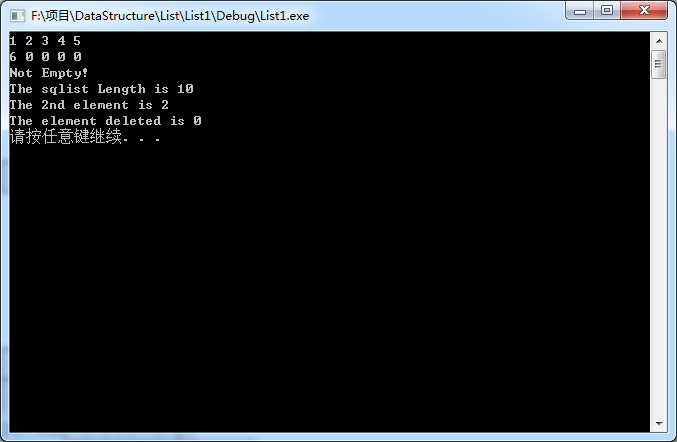1.表分类
- 顺序结构
- 链式结构
2.本文讲解顺序表
- 创建顺序表
```
#include <iostream>
#include <malloc.h>
using namespace std;
#define MAXSIZE 50
typedef int ElemType;
typedef struct
{
ElemType data[MAXSIZE];
int length;
}SqList;
void CreateList(SqList*&L,ElemType a[],int n);
int main()
{
ElemType a[10] = {1,2,3,4,5,6};
SqList* L;
CreateList(L,a,10);
for (int n = 0; n < 10; n++)
{
cout << L->data[n] << " ";
}
system("pause");
return 0;
}
void CreateList(SqList*&L, ElemType a[], int n)
{
L = (SqList*)malloc(sizeof(SqList));
for (int i = 0; i < n; i++)
{
L->data[i] = a[i];
}
L->length = n;
return;
}- 创建加显示显示顺序表
#include <iostream>
#include <malloc.h>
using namespace std;
#define MAXSIZE 50
typedef int ElemType;
typedef struct
{
ElemType data[MAXSIZE];
int length;
}SqList;
void CreateList(SqList*&L,ElemType a[],int n);//创建顺序表
void DisplayList(SqList *L);//输出顺序表
int main()
{
ElemType a[10] = {1,2,3,4,5,6};
SqList* L;
CreateList(L,a,10);
/*for (int n = 0; n < 10; n++)
{
cout << L->data[n] << " ";
}*/
DisplayList(L);
system("pause");
return 0;
}
void CreateList(SqList*&L, ElemType a[], int n)
{
L = (SqList*)malloc(sizeof(SqList));
for (int i = 0; i < n; i++)
{
L->data[i] = a[i];
}
L->length = n;
return;
}
void DisplayList(SqList*L)
{
if (L->length == 0)
return;
for (int i = 0; i < L->length; i++)
{
if (i != 0 && i % 5 == 0)
cout << endl;
cout << L->data[i] << " ";
}
cout << endl;
}加上一些其他的功能
【1】判断顺序表是否为空
【2】求顺序表的长度
【3】得到顺序表的某个位置上的元素
【4】按照元素的值查找在顺序表中的位置
【5】插入元素
【6】删除元素
【7】顺序表的初始化下面依程序的形式给出
#include <iostream>
#include <malloc.h>
using namespace std;
#define MAXSIZE 50
typedef int ElemType;
typedef struct
{
ElemType data[MAXSIZE];
int length;
}SqList;
void CreateList(SqList* &L,ElemType a[],int n);//创建顺序表
void DisplayList(SqList* L);//输出顺序表
void InitSqList(SqList* &L);//初始化顺序表
int LengthSqList(SqList* L);//得到顺序表的长度
bool IsEmptySqList(SqList* L);//判断顺序表是否为空
void DestroySqList(SqList* &L);//销毁顺序表
bool GetElemFromi(SqList*L,int i,ElemType &e);//得到第i位的元素
int GetiFromElem(SqList*L,ElemType e);//得到元素e所在的位置
bool InsertElemSqList(SqList* &L,int i,ElemType e);//在位置i处插入元素e
bool DeleteElemFromiSqList(SqList* &L,int i,ElemType &e);
int main()
{
ElemType a[10] = {1,2,3,4,5,6};
SqList* L;
InitSqList(L);//测试初始化顺序表
CreateList(L,a,10);//测试创建的顺序表
DisplayList(L);//测试显示顺序表
if (IsEmptySqList(L))//测试顺序表的空不空判断
cout << "Empty!" << endl;
else
cout << "Not Empty!" << endl;
cout << "The sqlist Length is " << LengthSqList(L) << endl;//测试求顺序表的长度
ElemType e;//测试得到i位置上的元素
GetElemFromi(L,2,e);
cout << "The 2nd element is " << e << endl;
GetiFromElem(L,e);//测试得到元素e的位置
InsertElemSqList(L,1,e);//测试插入元素
DeleteElemFromiSqList(L,10,e);//测试删除顺序表中的元素
cout << "The element deleted is " << e << endl;
DestroySqList(L);//测试销毁顺序表
system("pause");
return 0;
}
void CreateList(SqList*&L, ElemType a[], int n)
{
//L = (SqList*)malloc(sizeof(SqList));
InitSqList(L);
for (int i = 0; i < n; i++)
{
L->data[i] = a[i];
}
L->length = n;
return;
}
void DestroySqList(SqList* &L)
{
free(L);
}
void DisplayList(SqList*L)
{
if (L->length == 0)
return;
for (int i = 0; i < L->length; i++)
{
if (i != 0 && i % 5 == 0)
cout << endl;
cout << L->data[i] << " ";
}
cout << endl;
}
void InitSqList(SqList*&L)
{
L = (SqList*)malloc(sizeof(SqList));
L->length = 0;
}
int LengthSqList(SqList*L)
{
return L->length;
}
bool IsEmptySqList(SqList* L)
{
if (L->length == 0)
return true;
else
return false;
}
bool GetElemFromi(SqList*L, int i, ElemType &e)
{
if (i < 1 || i > L->length)
return false;
else
{
e = L->data[i - 1];
return true;
}
}
int GetiFromElem(SqList*L, ElemType e)
{
int i = 0;
for (; i < L->length, L->data[i] != e; i++);
if (i == L->length)
return 0;
else
return i + 1;
}
bool InsertElemSqList(SqList* &L, int i, ElemType e)
{
if (i < 1 || i >L->length + 1)
return false;
else
{
i--;
for (int j = L->length; j > i; j--)
{
L->data[j] = L->data[j - 1];
}
L->data[i] = e;
L->length += 1;
return true;
}
}
bool DeleteElemFromiSqList(SqList* &L, int i, ElemType &e)
{
if (i < 1 || i > L->length)
return false;
else
{
i--;
e = L->data[i];
for (int j = i; j < L->length - 1; j++)
{
L->data[j] = L->data[j + 1];
}
L->length -= 1;
return true;
}
}3.实验结果
4.总结
顺序表的分析还是挺简单的
【1】初始化:用mallooc函数动态生成,指定Length= 0
【2】创建:主要涉及到遍历数组的所有元素,把数组的所有元素赋值给顺序表,最后指定顺序表的长度
【3】显示:遍历顺序表的每一个元素
【4】销毁:free
【5】求长度:其实就是return L->Length
【6】判断空:其实就是L->Length 是不是为0
【7】插入:主要涉及到数组的移动;数组的物理标号和逻辑标号的区别,比如,数组a的第一个元素,其实是a[0]
【8】删除:也是涉及到数组的移动;数组的物理标号和逻辑标号的区别,比如,数组a的第一个元素,其实是a[0]
【9】得到位置i的元素e:遍历顺序表
【10】得到元素e的位置i:遍历顺序表,直到得到e

























 6792
6792

 被折叠的 条评论
为什么被折叠?
被折叠的 条评论
为什么被折叠?








